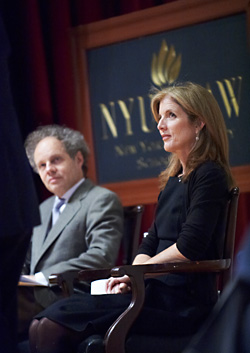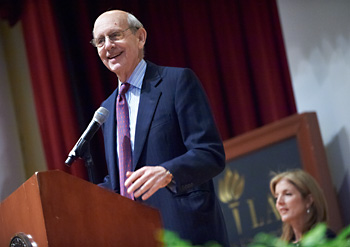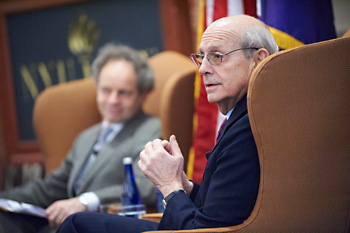Luminaries pay tribute to Edward Kennedy at [i]NYU Journal of Legislation and Public Policy[/i] dedication (VIDEO)
Luminaries pay tribute to Edward Kennedy at NYU Journal of Legislation and Public Policy dedication (VIDEO)
On February 1, the New York University Journal of Legislation and Public Policy dedicated its forthcoming special issue to the legislative legacy of the late Senator Edward Kennedy. The ceremony included warm tributes from Kennedy’s niece Caroline Kennedy and Supreme Court Justice Stephen Breyer.
 After an introduction by Sara Silverstein ’11, the journal’s editor-in-chief, Dean Richard Revesz reflected on Kennedy’s importance to American law. “Law schools are able to advance sound policy through the production of first-rate scholarship and the exchange of complex ideas, and Senator Kennedy’s work provides a rich and voluminous source of materials for advancing debate over a wide range of topics,” said Revesz. “There are few leaders who can provide a more shining example of the power of law and the political process to positively change people’s lives and shape a more perfect union.”
After an introduction by Sara Silverstein ’11, the journal’s editor-in-chief, Dean Richard Revesz reflected on Kennedy’s importance to American law. “Law schools are able to advance sound policy through the production of first-rate scholarship and the exchange of complex ideas, and Senator Kennedy’s work provides a rich and voluminous source of materials for advancing debate over a wide range of topics,” said Revesz. “There are few leaders who can provide a more shining example of the power of law and the political process to positively change people’s lives and shape a more perfect union.”
Caroline Kennedy focused in her remarks on her uncle’s personal touch: “More than almost anyone else I’ve ever met, Teddy’s humanity is what made him such a legislative giant.”
As the youngest of nine children, she said, Edward Kennedy knew the feeling of being crowded out. “I think it helped him develop his special gifts of always looking out for others, of making people laugh, and bringing them together no matter how differently they saw the world. He brought these gifts to the office. He saw the law as an instrument of social change, not in the abstract but in its effect on the everyday lives of those who were left out or left behind and needed his help.”
Caroline Kennedy recalled how her uncle called every grieving Massachusetts family after 9/11 and attended every funeral, typical of the senator’s approach. “He never stopped showing up.... Over the years he built a team of legal giants, and once someone had been on his staff they were always part of his extended family. He kept their phone numbers on a little pink card in his pocket, and he would call them at all hours of the day and night.”
 Every speaker stressed Edward Kennedy’s consummate bipartisanship, evident in his countless legislative achievements across party lines over the course of the more than 15,000 Senate votes he cast. Thomas Susman, who was assistant adviser to Kennedy on the Senate Judiciary Committee from 1968 to 1979, summed up the senator’s philosophy in reaching across the aisle: “Persuade, don’t trade. Don’t trade votes, don’t ask for personal favors. If you’ve got the position, persuade them. Get them there on the merits. But if you get someone giving you a vote that’s not on the merits, then that senator’s going to want one back, and he didn’t do that.”
Every speaker stressed Edward Kennedy’s consummate bipartisanship, evident in his countless legislative achievements across party lines over the course of the more than 15,000 Senate votes he cast. Thomas Susman, who was assistant adviser to Kennedy on the Senate Judiciary Committee from 1968 to 1979, summed up the senator’s philosophy in reaching across the aisle: “Persuade, don’t trade. Don’t trade votes, don’t ask for personal favors. If you’ve got the position, persuade them. Get them there on the merits. But if you get someone giving you a vote that’s not on the merits, then that senator’s going to want one back, and he didn’t do that.”
Justice Stephen Breyer, who had held a special Q&A session with NYU Law students earlier in the day, recalled his time working with Kennedy in the Senate, after Kennedy had appointed Breyer as the Judiciary Committee’s special counsel. The future Supreme Court justice later worked with Kennedy after returning to the Senate as the committee’s chief counsel.
“We used to just wake up in the morning and try to get there fast, because it was fun and interesting,” Breyer said of his special counsel days. “Every minute there was something going on. It’s that personality [of Kennedy’s] that just gripped the whole thing.”
Recently, Breyer said, Lamar Smith, the Republican chairman of the House Judiciary Committee, asked him to come speak to the committee, but did not say why beforehand. To Breyer’s surprise, Smith wanted to know how Kennedy ran the Senate Judiciary Committee when Breyer was chief counsel. This request was a testament, Breyer said, to the efficacy of Kennedy’s bipartisanship.
Kenneth Feinberg ’70, administrator of the Gulf Coast Claims Facility compensating those affected by the BP Deepwater Horizon oil spill, worked for Kennedy from 1975 to 1980, eventually becoming his chief of staff and general counsel to the Senate Judiciary Committee. Appearing on a large screen via webcam, Feinberg characterized Kennedy as one of a very few senators in modern times with “the political and institutional credibility to legislate” and achieve true partnership with members of the opposing party.
 The late senator worked tirelessly and went to great lengths to foster personal relationships with everyone in his orbit, Feinberg said. “He was constantly working from early in the morning till late at night, seven days a week, in order to achieve the endgame. He was driven by his name, by the history of his family, by the reputation he was determined to vindicate.”
The late senator worked tirelessly and went to great lengths to foster personal relationships with everyone in his orbit, Feinberg said. “He was constantly working from early in the morning till late at night, seven days a week, in order to achieve the endgame. He was driven by his name, by the history of his family, by the reputation he was determined to vindicate.”
Nick Littlefield, who worked as a staff director and chief counsel for Kennedy on the Senate Health, Education, Labor and Pensions Committee, explained how the senator accomplished as much as he did: through full immersion in the substance of issues, a holistic understanding of how both interior and exterior politics shaped how things in the Senate got done, and effective external communications.
Kennedy focused as much on unglamorous but crucial issues—job training programs, the minimum wage, administrative and regulatory policies—as on higher-profile ones. But one of his most lasting legacies, Littlefield said, would be universal healthcare, an issue on which Kennedy worked hard throughout his career.
Although the healthcare bill did not pass until after Kennedy’s death, Littlefield asserted that “he had a key role through the moral force of his personality, through his strategic sense, through being there for key votes, through talking to Obama, through the letters he wrote to Obama, through the speeches he gave. In many ways, universal healthcare in America is the great Kennedy legacy.... Let the history books report that this was the man who achieved more and affected the lives of more people in America probably than any other senator in United States history.”
Watch the full video of the event (1 hr, 13 min):
Posted on February 3, 2011

